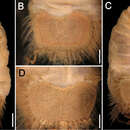Description
provided by Zookeys
Lectotype (ZMA 1535), with anterior end exposed, damaged; first five anterior segments light grey, opalescent with few cuticular papillae (Fig. 17A). Starting with segment seven, remainder of body darker grey or tan, and leathery in appearance. Cuticle covered with minute filamentous cuticular papillae over most of surface, especially on segments seven and eight, where papillae become longer. Two rows of loosely arranged dark spots with filamentous cuticular papillae on posterior segments starting with segment eight (better developed in paralectotype ZMA 1491). On segments dorsal to ventro-caudal shield, spots consist of slightly longer cuticular papillae with encrusting sediment at bases. Body up to 12.5 (6.5) mm long, 5.5 (2) mm wide, 29 segments.
Prostomium hemispherical, opalescent, light grey in colour. Peristomium rounded, raised at position of mouth, with a few papillae around base of prostomium. Mouth papillated, circular and small, positioned halfway between prostomium and anterior edge of segment two.
First three chaetigers with about six to ten larger, and five or more smaller, bronze, widely separated, slightly falcate introvert hooks per bundle, most with tips broken, with subdistal darker areas. Genital papillae protrude ventrally from intersegmental groove between segments 7 and 8 (Fig. 17A, C). Pre-shield region with 7 segments, without rows of fine capillary chaetae.
Ventro-caudal shield covered by fine papillae, with sediment particles firmly adhered on it; anterior margins rounded; anterior depression shallow or very shallow; suture not visible (Fig. 17B, D). Lateral margins rounded, medially expanded, narrowing posteriorly. Fan truncate, slightly expanded medially, margin smooth, with a shallow median notch (paralectotype ZMA 1491 with rust red in central area, with a wide bluish band of rings next, followed by another ring of rust red at outer margins, concentric lines not seen, basal layer porous).
Marginal chaetal fascicles include ten lateral ones, chaetae in a narrow oval arrangement, and five posterior fascicles, with chaetae in an offset linear arrangement, but roughly parallel to each other. Peg chaetae long, with a narrow base in cross section, emerge from cuticle, almost equalized to margin of shield. Additional delicate chaetae between peg chaetae and first bundle of posterior chaetae, almost included with peg chaetae.
Branchiae numerous, coiled, protrude from two widely separated plates, on dorsal surface adjacent to the ventro-caudal shield.
- license
- cc-by-3.0
- copyright
- Kelly Sendall, Sergio I. Salazar-Vallejo
- bibliographic citation
- Sendall K, Salazar-Vallejo S (2013) Revision of Sternaspis Otto, 1821 (Polychaeta, Sternaspidae) ZooKeys 286: 1–74
- author
- Kelly Sendall
- author
- Sergio I. Salazar-Vallejo
Distribution
provided by Zookeys
Andaman Sea to Southeastern Australia, 39–147 m depth. Kastoro et al. (1989) think this is a very common estuarine species in East Java, in 0.3–20.0 m, and salinities of 29.3–34.0 ‰.
- license
- cc-by-3.0
- copyright
- Kelly Sendall, Sergio I. Salazar-Vallejo
- bibliographic citation
- Sendall K, Salazar-Vallejo S (2013) Revision of Sternaspis Otto, 1821 (Polychaeta, Sternaspidae) ZooKeys 286: 1–74
- author
- Kelly Sendall
- author
- Sergio I. Salazar-Vallejo

